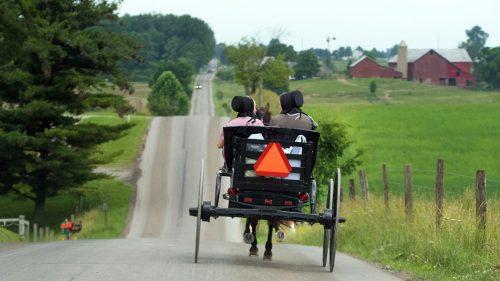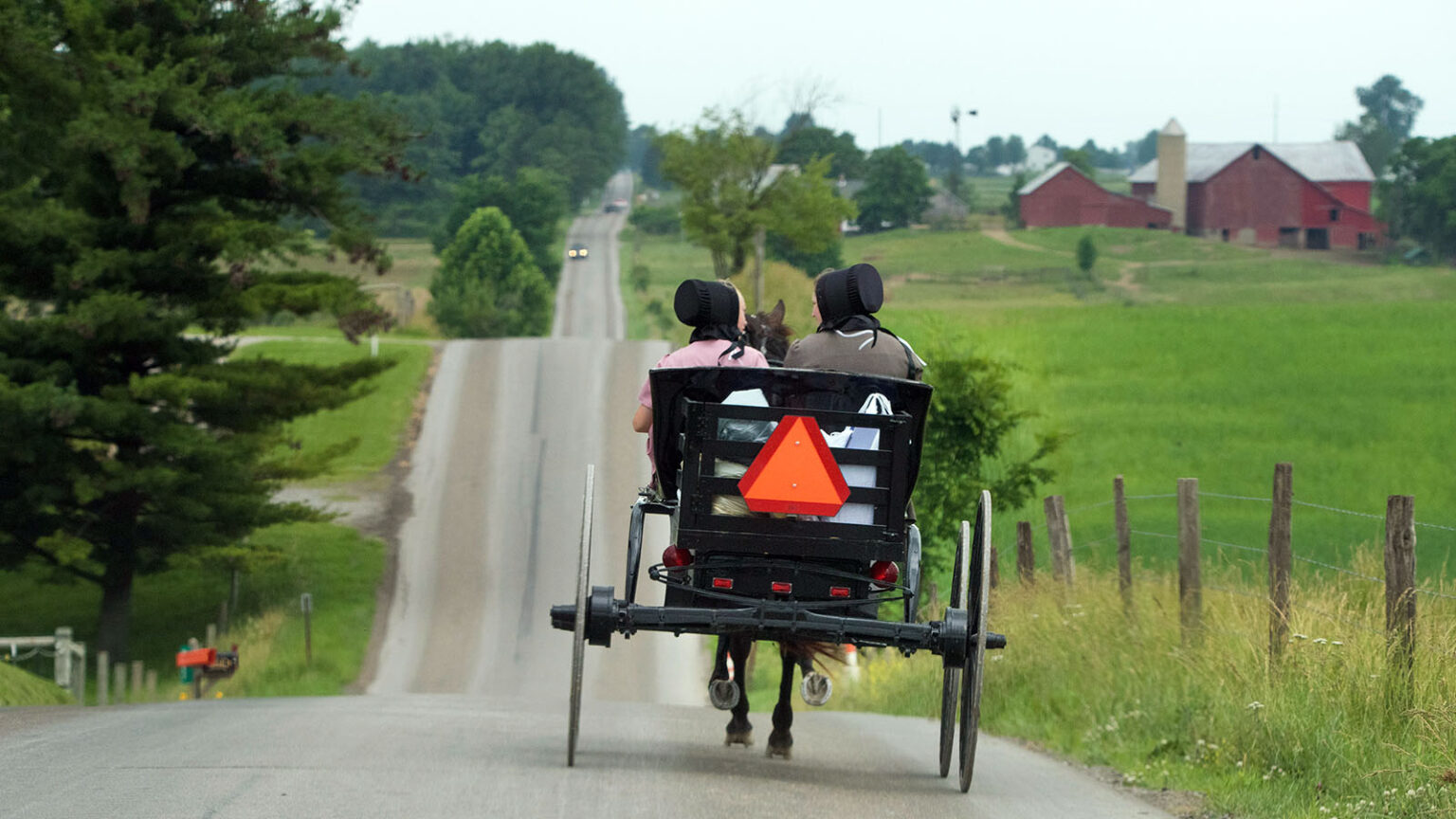(RNS) – In bodycam footage from an April 2023 traffic stop in rural Ohio, an unseen police officer approaches a spartan black horse-drawn carriage, a typical Swartzentruber Amish vehicle, and asks the two young men inside if they have ever received a traffic ticket.
“I think I’m going to tow your buggy unless you have lights in it,” says the cop.

(Photo by Randy Fath/Unsplash/Creative Commons)
The driver, a young man named Ure Gingerich, first appears confused, then defiant. “Tow it away if you want!” He later reminds the police officer that he could fight back, but that goes against his beliefs. “I’m not going to get a lawyer, but I’m just telling you that I could.”
The sight has become commonplace in some counties in central and eastern Ohio, where a significant number of Swartzentrubers – the most conservative sect of the Amish – live, who have run afoul of a new law requiring all horse-drawn carriages to be fitted with a flashing yellow LED light for better visibility. While the state claims the new measures are essential for safety, the Swartzentrubers and other conservative Amish groups say their right to religious freedom is being unfairly violated. And although the Amish typically shy away from litigation, help for the Ohio Swartzentrubers came from an unexpected source: Harvard University Law School.
On Tuesday (Aug. 20), attorneys and students from Harvard University’s Religious Freedom Clinic, along with Ohio-based law firm Taft Stettinius & Hollister, filed a lawsuit in Hardin County, seeking a preliminary injunction that would immediately halt enforcement of the law across the state. They argue that the law violates numerous constitutional rights, including that it prevents the Swartzentrubers from freely practicing their faith and unreasonably restricts their freedom of movement across the state.

(Photo by Joshua J. Cotten/Unsplash/Creative Commons)
The new rule was originally introduced in 2021 by Republicans Darrell Kick and Scott Wiggam as House Bill 30 and signed into law in the summer of 2022. It was intended to reduce the number of accidents involving horse-drawn carriages and cars in areas where the Amish, who oppose driving and car ownership, and the “English” live side by side. State data collected and released in 2020 indicate that there were between 60 and 84 such accidents annually from 2009 to 2019; the number of fatalities increased, rising from six between 2009 and 2015 to nine between 2016 and 2019. Because horse-drawn carriages can be made of metal, fiberglass and wood, the occupants often suffer more damage than the occupants of the cars.
But the Swartzentruber community, which makes up about 12 percent of the state’s Amish, largely refuses to comply. They view the lights as frivolous decorations that run counter to the sect’s commitment to religious simplicity. And members are wary of deviating from tradition, since the Bible prescribes honoring one’s ancestors.
In response to an earlier, failed attempt by Ohio to mandate flashing lights in 2020, Abe Mast, a member of another conservative sect known as the Kenton Amish, submitted testimony to the House Transportation and Public Safety Committee arguing that his community was being scapegoated. “We believe the most common causes of accidents are the use and influence of drugs and alcohol, and the use of cell phones while driving,” Mast wrote.
And in an analysis of the bill released at the time, the state noted that there could be a potential violation of the First Amendment, citing a similar case in Wisconsin that had ruled in favor of the Amish opposition.
Over the years, similar laws were passed in Michigan, Wisconsin, Minnesota, Pennsylvania and Kentucky, requiring slow-moving vehicles to display emblems such as bright yellow triangles. In all of these cases, the law was eventually changed to accommodate the Swartzentrubers, who found culturally acceptable workarounds, including lamppost lights or gray reflective strips.
Politicians knew that opposition could arise again. Ohio lawmakers who introduced House Bill 30 took pains to show that they had secured Amish support, notably by producing a handful of letters from members of the Amish community who supported it. Two of them were from Swartzentrubers. (None of the letters are signed.)
Since the law came into effect, there have been allegations that police have gone out of their way to target black-centred drivers. Black-centred drivers have been ticketed on their way home from court; police have waited outside church services on Sundays to catch as many drivers as they can as they drive away. In one case, a couple with children in their stroller were struck from behind by a motorist and charged with child endangerment, a charge that carries a potential prison sentence.

(Photo by Randy Fath/Unsplash/Creative Commons)
Men who were repeatedly ticketed refused to pay the fines and were hauled back into court, much to the annoyance of everyone involved. They expressed their theological problems with the law, but always out of context or too late. “You can’t show up in court in November, plead ‘no contest,’ fail to address the constitutional issue, be found guilty, be convicted and wait six months and then say, ‘Hey, I want the case dismissed because it’s unconstitutional,'” Ashland County Judge John Good told the defendants in Swartzentruber in May 2023.
The Amish have “zero knowledge” of the court system, says Cory Anderson, a Holmes County sociologist who has communicated with the Swartzentruber community on the issue and is now supporting Harvard’s case. Although excessive litigation is frowned upon, the Amish can defend themselves under certain conditions, said Anderson, who studies conservative Anabaptists, including the Amish.
“They don’t ask directly for lawyers to represent them, and they don’t pay lawyers because they believe they are ‘defenseless Christians,'” says Anderson, a Plain Mennonite who shares many theological and cultural similarities with the Amish.
When the Amish receive legal assistance, it is often because someone outside the community offers them legal representation, as in the famous case of Wisconsin v. Yoder., In that case, a group of academics, lawyers and civil rights activists joined together to argue that Amish children should be exempt from higher education. (The Supreme Court sided with the Amish in 1972.) The American Civil Liberties Union provided legal counsel in other cases involving the Swartzentruber buggies.
This time, Anderson put out feelers to various companies to find out who could step in. A game of attorney-client privilege ensued until news of the Swartzentrubers’ predicament finally reached Harvard.
Founded in 2020, Harvard Law School’s Religious Freedom Clinic is part of a wave of similar organizations at prestigious institutions such as Stanford, Yale and Notre Dame. The clinic worked on a lawsuit by a Lakota family in Nebraska whose children’s hair was forcibly cut by school staff, as well as the case of John Henry Ramirez, a death row inmate in Texas who sought a dispensation to have his pastor pray with him and touch him during his execution.
Steven Burnett, a fellow at the Religious Freedom Clinic, said the precedents from other states bode well for the Swartzentrubers. “It’s the same kind of tension between a perceived safety interest and a religious interest,” he said, noting that the idea of safety “looms over many” religious freedom cases Harvard handles. But a close look at the data, he said, shows that it’s too easy to equate visibility with fewer accidents. Accidents between horse-drawn carriages and cars “to a large extent” occur during the day, he said, in good weather and on straight roads, often when a car sees a horse-drawn carriage and tries unsuccessfully to pass it.
The Harvard students and faculty working on the case have built good relationships with their clients, whom they have traveled to meet several times, according to Burnett. Although the Amish can be reserved and taciturn – their faith encourages them to speak minimally and cautiously – Burnett said they have been “very warm, very welcoming,” even cooking a large meal for their visitors. “They don’t show their gratitude in normal, common American ways,” he said, “but I never got the sense that they weren’t grateful.”
Burnett attributes Ohio’s initial skepticism to the Swartzentrubers’ claims that the Amish are monolithic. “They assume that some Amish comply with safety regulations and other Amish who refuse to comply do so for dishonest or non-religious reasons,” he said. But when the students visited the Swartzentrubers’ homes, which have no electricity or water, they saw firsthand the depth of their clients’ low-tech leanings. “They explained their beliefs in an understandable and honest way.”
Burnett says Harvard’s approach is aimed at getting the most comprehensive compensation possible as quickly as possible – rather than dealing with each of the hundreds of subpoenas individually. But depending on how judges interpret the case, it could take years for the Swartzentrubers and other conservative Amish to receive a final judgment.
“I think a lot of judges think that if I admit that and then someone dies in a car accident or a buggy accident, then it’s my fault,” he said. “But people let safety prevail over our various rights a little too quickly.”
This story has been updated to clarify that Anderson’s communications with the Swartzentrubers were informal.

